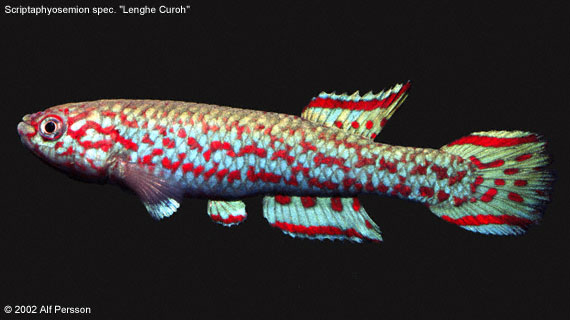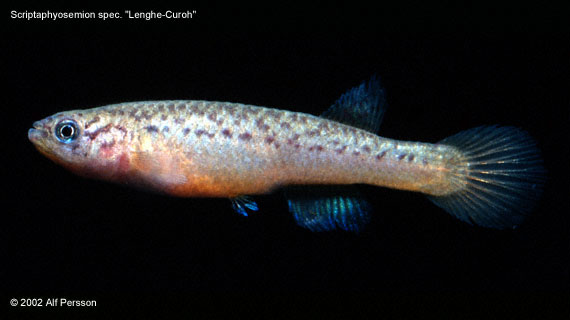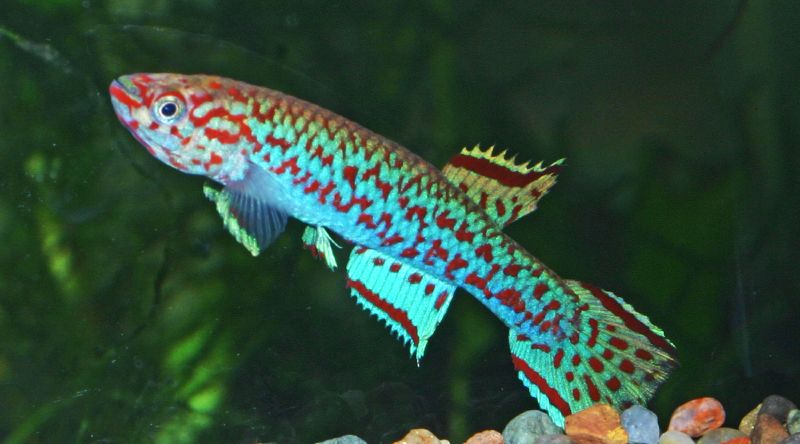Rev. 21-10-2018
Terra typica:-"Sierra Leone, Lenghe Curoh, Sanghi or Sanigi River, field number SL 03/16 (9°28,04’ N, 11°40,58’ W), E. Busch and B. Wiese, 18. Nov. 2003."
 |
 |
Status: Valid species.
Etymologi: The new species is named after Barbara Wiese, who accompanied the second author on most of his research trips in West Africa and was the first who recognized it as a new Scriptaphyosemion species. (Sonnenberg & Busch, 2012).
| Synonyms: | Roloffia species "Lenghe-Curoh, SL 93/37" |
| Aphyosemion species "Lenghe-Curoh, SL 93/37" | |
| Scriptaph. bertholdi "Lenghe-Curoh, SL 93/37" |
Description:
Meristics:
| Holotype | Paratypes |
Paratypes |
all Types mean | all Types range | all Types SD |
| SL | 36.0 | 25.1 | 24.7 | 25.6 | 21.5-36.0 | 4.0 |
| TL | 119.7 | 124.4 | 122.5 | 123.2 | 119.7-127.0 | 2.2 |
| HL | 26.3 | 26.6 | 26.9 | 26.7 | 25.1-28.9 | 1.3 |
| PD | 66.0 | 65.1 | 64.9 | 65.0 | 61.2-67.8 | 2.0 |
| pPED | 27.7 | 27.4 | 27.9 | 27.6 | 25.9-29.8 | 1.1 |
| pPD | 45.3 | 47.2 | 46.6 | 46.8 | 44.7-49.4 | 1.3 |
| pAD | 57.3 | 57.8 | 57.5 | 57.7 | 54.9-59.8 | 1.5 |
| DB | 19.5 | 19.8 | 19.3 | 19.6 | 18.7-21.7 | 0.8 |
| DC | 12.3 | 11.9 | 11.4 | 11.7 | 10.9-12.3 | 0.5 |
| CL | 23.3 | 22.4 | 22.5 | 22.5 | 21.1-23.6 | 0.7 |
| BD | 17.6 | 16.3 | 15.7 | 16.1 | 14.4-17.6 | 1.0 |
| BA | 21.1 | 20.4 | 19.1 | 19.8 | 17.9-21.5 | 1.0 |
| E | 5.4 | 6.5 | 6.5 | 6.4 | 5.4-7.3 | 0.5 |
| I | 11.2 | 9.5 | 9.6 | 9.7 | 8.6-1.2* | 0.6 |
Morphometrics of Scriptaphyosemion wieseae, new species. Values in the
table are based on 15 specimens, for which
all measurements and counts were taken (7 of each male and female paratypes).
All measurements in percentages of standard length
(SL) except standard length in mm. TL = total length, HL = length of head,
PD = predorsal fin distance, pPED = prepectoral fin
distance, pPD = prepelvic fin distance, pAD = preanal fin distance, DB =
greatest body depth, DC = caudal peduncle depth, CL =
length of caudal peduncle, BD = base of dorsal fin, BA = base of anal fin,
E = eye diameter, I = interorbital width, SD = standard
deviation.* possibly 8.6-11.2 (Sonnenberg & Busch, 2012).
Snout slightly pointed, mouth directed upwards, lower jaw longer than
upper jaw, posterior end of rictus at the level of the dorsal third to centre
of eye. Teeth curved and unicuspid, on dentary an outer row of larger teeth,
inner rows more or less regular with smaller teeth. Premaxilla with an outer
row of larger teeth and a small number of short teeth irregularly on the
inner part. Closed frontal neuromast system within one groove, preopercular
neuromast system with 5 pores.
Scales cycloid, body and head completely scaled, except for ventral surface
of head. Frontal squamation of Gtype; scales on lateral line 27–30
+ 2–3 scales on caudal fin base. Transverse rows of scales above pelvic
fin 9; circumpeduncular scale row 12–14.
Tips of dorsal, anal, and, in some males, also caudal fin slightly pointed,
but no filamentous extensions, caudal fin truncate. Fins in females are
generally smaller and more rounded. Dorsal and anal fin origin posterior
to mid-body. First dorsal fin ray posterior to origin of anal fin, situated
above anal fin ray 4–6. Dorsal fin with 12–13 rays, anal with
16–17 rays, caudal fin with 25–28 fin rays. Pectoral fin rounded,
fin origin on ventral half of side, just posterior to operculum, directed
posteriorly, not reaching pelvic fin origin. Pelvic fin small, origin ventrally,
directed posteriorly, not or just reaching anal fin origin. Total number
of vertebrates 29–30, of which 13–14 have pleural ribs and 15–16
have haemal spines.(Sonnenberg & Busch, 2012).
Genetics: #DNA study by Sonnenberg places ####
Phenotype: #
Systematics:
Phenotype: Description of closely related species. (With focus on differences between species).
Scr. bertholdi: Steel blue body coloration with red dots which
generally are smaller than the scales. Throat is white with no red pattern.
Unpaired fins are green-blue with red sub marginal bands and white to light
blue marginal bands, never yellow marginal bands in caudal fin.
Distribution: Is known from the Sewa, Waanje, Moa and Lofa? drainages. Is
normally found at higher altitudes (inland plateau) but a few populations
were discovered at lower altitudes.
Scr. chaytori: Body side blue with red spots, normally larger than
scales. Red spots are often arranged in a zigzag or check board pattern.
Throat is normally white with no red pattern (2 populations have few red
dots at the throat). With a red vertical border in caudal fin. Unpaired
fins are green-blue with red sub marginal band and white to light blue marginal
bands, yellow or blue marginal bands in caudal fin.
Distribution: The 2 closest populations (Masankori and Kamabai), are from
tributaries to the Little Scarcies River. Lowland species, have not been
collected above 150 m.
Scr. guignardi: Light blue to green body coloration with red dots
which normally are smaller than the scales. Dots are ocasionally arranged
in a chevron pattern. Throat is white with no red pattern. Unpaired fins
except the anal fin are green-blue with red sub marginal bands and white
to light blue marginal bands, never yellow marginal bands in caudal fin.
The anal fin are green-blue with a black marginal band, but some populations
or specimens have red sub-marginal bands.
Distribution: Guinea-Mali-Burkina Faso.##
#Scr. wieseae: Blue body coloration with red dots which generally
are smaller than the scales. Red pattern is arranged in 2 horizontal lines.
Red lines at white throat. Unpaired fins are green-blue with red sub marginal
band and white to light blue marginal bands, never yellow marginal bands
in caudal fin.
Distribution: The 3 known populations were found in tributaries to the Seli
or Rokel drainage. Inland plateau species.#
Kropside Som oftest er over i det ##, . Det faktum at Scriptaph. species
"Lenghe-Curoh" lever syntopt eller sympatrisk ? med Archiaph.
guineense, viser at den har samme biotopvalg som Scriptaph. bertholdi,
hvilket også tyder på at populationen kan henføres til
Scriptaph. bertholdi.
The male Scr. wieseae "Lenghe-Curoh" differs from Scr.
bertholdi by throatpattern and body coloration. The throat of the male
has a lot of red pigment, a trait only known from Scr. geryi (totally
red throat), from Scr. chaytori "Nom-Mussiray, SL93/38"
(a few red lines) and Scr. chaytori "Gbogonma, SL85/9b"
(a few red spots) and Cal. monroviae (a complex pattern of lines
and spots). #Som oftest er over i det #lyseblå# hos BER, . #The male
has more red pigment on the flanks than has Scr. bertholdi#, the
red pigment is #sometimes more or less arranged in 2-3 horisontal lines.
Females of Scr. wieseae "Lenghe-Curoh" can not be separated
from Scr. bertholdi or Scr. chaytori females.
The
fact that Scr. wieseae "Lenghe-Curoh" lives syntoptic with
Arch. guineense, reveals that it prefer the same type of habitat
as Scr. bertholdi, which also indicates that the species is closely
related to Scr. bertholdi.
#
Distribution: #Distribution and habitat.
Scriptaphyosemion wieseae is currently known from three localities in the
upland of northern Sierra Leone between the Sula and Wara Wara mountains
(Fig. 1); all of these are located within the Seli or Rokel River basin.
At the collection localities Fadugu (SL 03/15) and Lenghe Curoh (SL 03/16),
S. wieseae is present in small rivers, at the former place together with
Epiplatys cf. njalaensis, Archiaphyosemion guineense, undetermined characids,
gobies, and cyprinids, probably Barbus leonensis, B. stigmatopygus and a
small undetermined Barbus specimen; at the latter place it was collected
together with A. guineense. At Kabala (SL 03/17), only a small number of
mostly juvenile specimens were collected in large rice swamps. The second
author visited this area two times, in 1993 and 2003, and noticed an intensified
agricultural land usage. Collections of the second author during four collection
trips between 1989 and 2003 suggest that there is no overlap of the distribution
areas of S. bertholdi and S. wieseae (Fig. 1). Scriptaphyosemion bertholdi
inhabits southeastern Sierra Leone and is found in river basins which enter
the Atlantic ocean through the southern costal area (Huber 2007; Wildekamp
1993; Wildekamp & Van der Zee 2003), whereas S. wieseae inhabits the
upper tributaries of the Seli or Rokel River, which enter the Atlantic ocean
more to the north (Fig. 1). The geographically closest Scriptaphyosemion
species with regard to the known collection localities of S. wieseae is
S. chaytori (Fig. 1), to the north in Guinea it is S. guignardi (Busch 1995a;
Wildekamp & Van der Zee 2003; own unpublished collection data)(Sonnenberg
& Busch, 2012).
The discovery by Rob Palmer in 2013 of a species similar to Scr. bertholdi in the Tonkolili drainage, only some 40 km south of Scr. wieseae populations, is very interesting. The Tonkolili River is a tributary to the Rokel or Seli River, as is the Mabakah River and Sanghi River where Scr. wieseae is found. This discovery questions the secluded position and there is probably an unbroken chain of populations between type localities of the two species.
| Code | Locality | Date | Species | Geo. coordinates | Alt. | Source |
| SL 03-15 | Fadugu, at the bridge over the Mabakah River. | 18. Nov. 2003 | Scr. wieseae, Ep. cf. njalaensis, Archiaph. guineense, undetermined characids, gobies, and cyprinids, probably Barbus leonensis, B. stigmatopygus and a small undetermined Barbus specimen | 9°23,52' N, 11°45,76' W | 295m | 3 |
| SL 93-37 | Lenghe Curoh. | Nov-Dec. 1993 | Scr. wieseae, Archiaph. guineense | (Note!=SL 03-16) | 378m | 1,2,3 |
| SL 03-16 | Lenghe Curoh, Sanghi or Sanigi River. | 18. Nov. 2003 | Scr. wieseae, Archiaph. guineense | 9°28,04' N, 11°40,58' W | 378m | 3 |
| SL 03-17 | Kabala, collected in rice swamp. | 18. Nov. 2003 | Scr. wieseae, only a small number of mostly juvenile specimens were collected in large rice swamps. | 9°35' N, 11°33' W | 443m | 3 |
Variation: At present only the "SL 93-37, Lenghe-Curoh" population is distributed #.
 |
| Fig. 3: -"Male of Scr. wieseae "Lenghe-Curoh"?, the red pattern of the throat is just visible. Photo: C. Grimes. |
Literature: